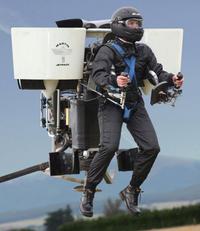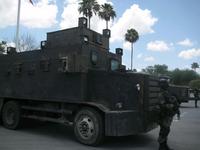-
New smartphone app reduces information overload
Researchers have developed a new smartphone application to avoid information overload by processing large quantities of data in real time and presenting it in user friendly clusters; the software is the first to allow a user to make real time adjustments to how information is displayed on a phone as it is acutely “aware” of how cluttered the screen is; the new application can be used in a wide array of instances including natural disasters, monitoring multiple hospital patient’s heart levels, and mapping the locations of first responders deployed during an emergency
-
-
N.Y. Dems push for gun microstamping legislation
New York legislators are pushing for new gun technology that could help law enforcement officials fight crime; microstamping is a new technique that stamps a code on shell casings ejected when a gun is fired; the code can provide valuable information like the dealer who sold it and the buyer who purchased it; this week marks the end New York’s current legislative session and Democratic lawmakers are pushing to get the Republican controlled Senate to take up a bill that would require guns in New York to be microstamped
-
-
Technology helps law enforcement predict threats -- and prepare for them
3i-MIND is the LEIM 2011 event to show its technology — a family of configurable solutions which help law enforcement agencies gather and analyze open-source and other intelligence in order to predict and prepare for threats; the technology uses deep-Web tools to access leads found only in social networks, chat rooms, and online forums
-
-
New powertrain improves fuel economy, adds hp Chevrolet Impala Police
GM says that a new 3.6L V-6 engine and a 6-speed automatic transmission achieves 302 hp and an estimated fuel economy of 17 mpg city and 27 mpg highway — a 3 mpg advantage over previous Impala models and 28 percent better than the Ford Crown Victoria; the 2012 Impala can accelerate from 0-60 mph in 6.6 seconds, based on GM engineering tests
-
-
Apple cracks down on drunk driving evasion apps
At the urging of several U.S. senators, Apple recently announced that it would no longer sell apps that were designed to inform users about police checkpoints for drunk drivers; the senators lauded the move, but said that the company should also remove existing apps from its stores rather than just preventing new ones from going on sale; the senators were targeting apps like PhantomALERT which taps into a phone’s GPS device and alerts the driver of any active law enforcement zone including checkpoints, speed cameras, and speed traps
-
-
Massachusetts firefighters purchase chemical fire equipment
Local firefighters in Massachusetts recently received a new foam trailer capable of pumping out 500 gallons per minute; to control chemical fires and other difficult blazes, firefighters often use foam to coat the fuel to deprive the fire of oxygen; the new foam trailer is particularly useful as Ayer is home to several chemical and electrical facilities
-
-
Three arrested in PlayStation cyberattacks

On Friday, Spanish law enforcement officials arrested three men suspected of hacking into Sony’s PlayStation Network in addition to other major government and corporate websites around the world; the three men are suspected of being the local leaders of a secretive group of international hackers that call themselves Anonymous; the group has claimed responsibility for several high profile attacks on major sites like YouTube, Amazon, the Australian Parliament’s House website, and PayPal
-
-
Firefighters struggling with Arizona's second largest wildfire in history

Firefighters in eastern Arizona are struggling to contain the second largest wildfire in the state’s history; as the blaze burns toward New Mexico, Arizona officials have been forced to evacuate mountain resort communities and close national forests and parks; the wildfire has been burning steadily since 29 May; the conflagration now covers more than 311,000 acres in the White Mountains of eastern Arizona, and is threatening to damage power lines carrying electricity to Tucson; the fire is growing at a rate of four to five miles a day and protracted drought and dry, high winds have hampered efforts to control the blaze
-
-
DHS reduces monitoring of non-Islamic domestic terrorism

In May 2009, DHS issues a report saying that the recession and Obama’s election could lead to a “violent radicalization” of extremist groups in the United States; conservative politicians and commentators charged that the report was an attack on conservative ideology and groups opposing abortion and immigration; in response, DHS has eviscerated the analytical unit which issued the report, cut the number of personnel studying domestic terrorism unrelated to Islam, canceled state and local law enforcement briefings, held up dissemination of nearly a dozen reports on extremist groups, and has blocked the dissemination of a digest of domestic terror incidents and the distribution of definitions for terms such as “white supremacist” and “Christian Identity”; state and local law enforcement and security experts are worried
-
-
Emergency responders could have jetpacks by year's end

Emergency responders in New Zealand could soon be zipping around on personal jetpack; last month, Glenn Martin, an inventor based in New Zealand, successfully flew his jetpack up to a height of nearly 5,000 feet; Martin has been hard at work on the jetpack for the last thirty years and hopes to have his “jetski for the skies” commercially available within eighteen months; the jetpack is essentially two two-liter V4 engines strapped to a carbon fiber frame; the device is wingless and is controlled by two joysticks and can be flown with little pilot training; Martin says that the first people to use the device will be emergency responders conducting search and rescue missions
-
-
Sheriffs in Pasco County, Florida to stop crimes before they happen

Local law enforcement officials in Florida are taking a new more proactive approach to fighting crime; last week Pasco County Sheriff Chris Nocco announced that the department would begin implementing what he calls “intelligence-led policing”; under his plan, officers will focus on gathering intelligence and sharing that information with local, state, and federal agencies to stop crimes before they occur; according to Sheriff Nocco 6 percent of offenders commit 60 percent of crimes, and so his department will begin more closely monitoring these individuals; Nocco has requested additional staff to help map crime patterns and share intelligence; critics of the approach are concerned about the notion that police officers are closely monitoring people who have not committed any crimes
-
-
A machine that predicts crime
The very effort by individuals who are intent on committing a crime to mask their intent has detectable physiological manifestations; it should thus be possible to build a sensor which would identify these manifestations and correlate them with the underlying malintent
-
-
Anytime, anywhere communications across all devices enhances collaboration

Connecticut-based company offers anytime, anywhere communications across all types of devices — allowing public safety, emergency response, and select critical infrastructure entities to communicate and collaborate in the event of an emergency; the system may also be used by the military — in the field thousands of miles away — to alert, and provide information to in real time, domestic emergency agencies
-
-
42 million displaced by natural disasters in 2010

In 2010 approximately forty-two million people were displaced from their homes due to natural disasters, more than double the number of people forced to relocate in 2009; the latest numbers were calculated by the Internal Displacement Monitoring Centre (IDMC), which found that more than 90 percent of disaster displacements were the result of weather-related events; the number of natural disasters has doubled from roughly 200 to over 400 a year during the last twenty years; the report found that countries on all continents were affected by the increase in natural disasters, but Asian countries have been hit the hardest
-
-
Mexican drug cartels build "narco tanks"

In the latest development in Mexico’s bloody drug trade, it seems that rival cartels are building large armored vehicles in their fight against one another; over the weekend, the Mexican Army found two “Mad Max” style “narco tanks” in Ciudad Camargo in the state of Tamaulipas near the Texas border; the two vehicles had inch-thick steel armor and were built on a three-axle truck bed with a heavily armored cabin; the vehicles were capable of withstanding fire from 50 caliber mounted weapons and grenade blasts; so far none of the tanks have been used to confront the Mexican Army and officials believe that they are primarily used in inter-gang warfare
-
More headlines
The long view
Why Was Pacific Northwest Home to So Many Serial Killers?
By Jacob Sweet
Ted Bundy, Gary Ridgway, George Russell, Israel Keyes, and Robert Lee Yates were serial killers who grew up in the Pacific Northwest in the shadow of smelters which spewed plumes of lead, arsenic, and cadmium into the air. As a young man, Charles Manson spent ten years at a nearby prison, where lead has seeped into the soil. The idea of a correlation between early exposure to lead and higher crime rates is not new. Fraser doesn’t explicitly support the lead-crime hypothesis, but in a nimble, haunting narrative, she argues that the connections between an unfettered pollution and violent crime warrant scrutiny.
Bookshelf: Smartphones Shape War in Hyperconnected World
By Kathryn Brimblecombe-Fox
The smartphone is helping to shape the conduct and representation of contemporary war. A new book argues that as an operative device, the smartphone is now “being used as a central weapon of war.”
